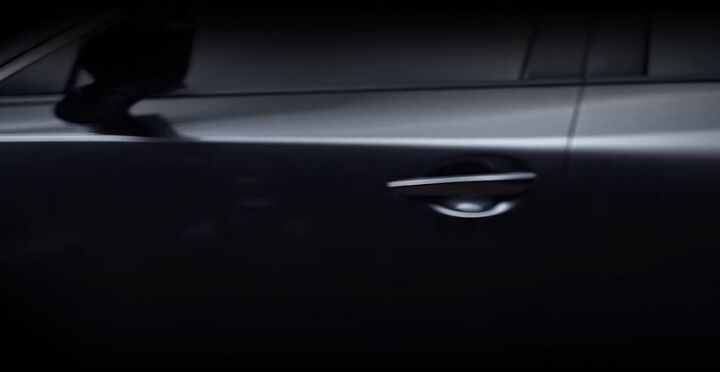Teaser Vid Heralds a New Mazda 3 and a New Way to Burn Gasoline

“A new era begins” in November, Mazda’s YouTube video announces, but the automaker is likely referring to more than just the car seen in the teaser.
The next-generation Mazda 3, snippets of which can be seen in both hatchback and sedan form, will be joined by a new gasoline engine that’s far more monumental than any revamped compact car.
As you can see from the link, there’s not to actually see, though the hatch’s severely sloped rear calls to mind the brand’s Kai concept, released last year. It was assumed at the time that the Kai would serve as inspiration for the 2019 Mazda 3. In the video’s side-on peek, the new vehicle’s flanks appear not quite as featureless; however, it’s clear the highly accentuated fender bulges of years past will soon be a thing of the past.
The date listed in the video points to a product unveiling at next month’s L.A. Auto Show, so that’s something to look forward to. This author, as well as other TTACers, remain fans of the current-gen 3 — specifically the 2.5-liter/six-speed GT version. It’s a fun little front-driver that enthusiastically and capably eats up twisty back roads, and its KODO design language earns two thumbs way up.
Whatever the 2019 model’s looks, the most radical change will lie under the hood. The new 3 serves as the first application of Mazda’s Spark Controlled Combustion Ignition (SPCCI) engine — a high-compression 2.0-liter four-cylinder that blends characteristics of both gasoline spark ignition and diesel compression ignition for greater efficiency and power.
To overcome inherent problems with gasoline compression ignition (temperature-related pre-ignition or lack of any ignition), Mazda kept a source of spark in the combustion chamber. It calls the new mill the Skyactiv-X.
Located in close proximity to the injector, the spark plug ignites only a small burst of fuel injected near the end of the compression stroke, right as the piston reaches the top of its travel. The resulting burn from this small, localized charge increases pressure in the cylinder, resulting in the combustion ignition of a pre-existing fuel-air mix that wasn’t concentrated enough to ignite on its own. This leads to a more diesel-like power signature and greater fuel efficiency.
Despite having a plan for electrification, Mazda remains of the few automakers without a hybrid or electric vehicle in its lineup. The investment in SPCCI was seen as a way of lengthening the gasoline engine’s lifespan while also making nice with the EPA. Assuming Mazda worked out all the bugs, the new tech stands to create a cheaper and less complex high-MPG vehicle.
[Images: Mazda/ YouTube]

More by Steph Willems
Latest Car Reviews
Read moreLatest Product Reviews
Read moreRecent Comments
- Spectator Wild to me the US sent like $100B overseas for other peoples wars while we clammer over .1% of that money being used to promote EVs in our country.
- Spectator got a pic of that 27 inch screen? That sounds massive!
- MaintenanceCosts "And with ANY car, always budget for maintenance."The question is whether you have to budget a thousand bucks (or euro) a year, or a quarter of your income.
- FreedMike The NASCAR race was a dandy. That finish…
- EBFlex It’s ironic that the typical low IQ big government simps are all over this yet we’re completely silent when oil companies took massive losses during Covid. Funny how that’s fine but profits aren’t. These people have no idea how business works.



































Comments
Join the conversation
Engine tech reminds me a little of Honda's stratified charge CVCC engines. That was clean, efficient, no-catalytic-converter-needed wonder technology for the otherwise malaise-ish 1970s. Wonder why Honda never followed up on those.
I certainly hope we get an electric Mazda with rotary range extender. Great application for a smooth, compact rotary. Of course, rotaries are neither clean-burning nor fuel-efficient, so the car would be green only on battery power, so hopefully they could wedge enough battery in there for 70-150 miles on EV.